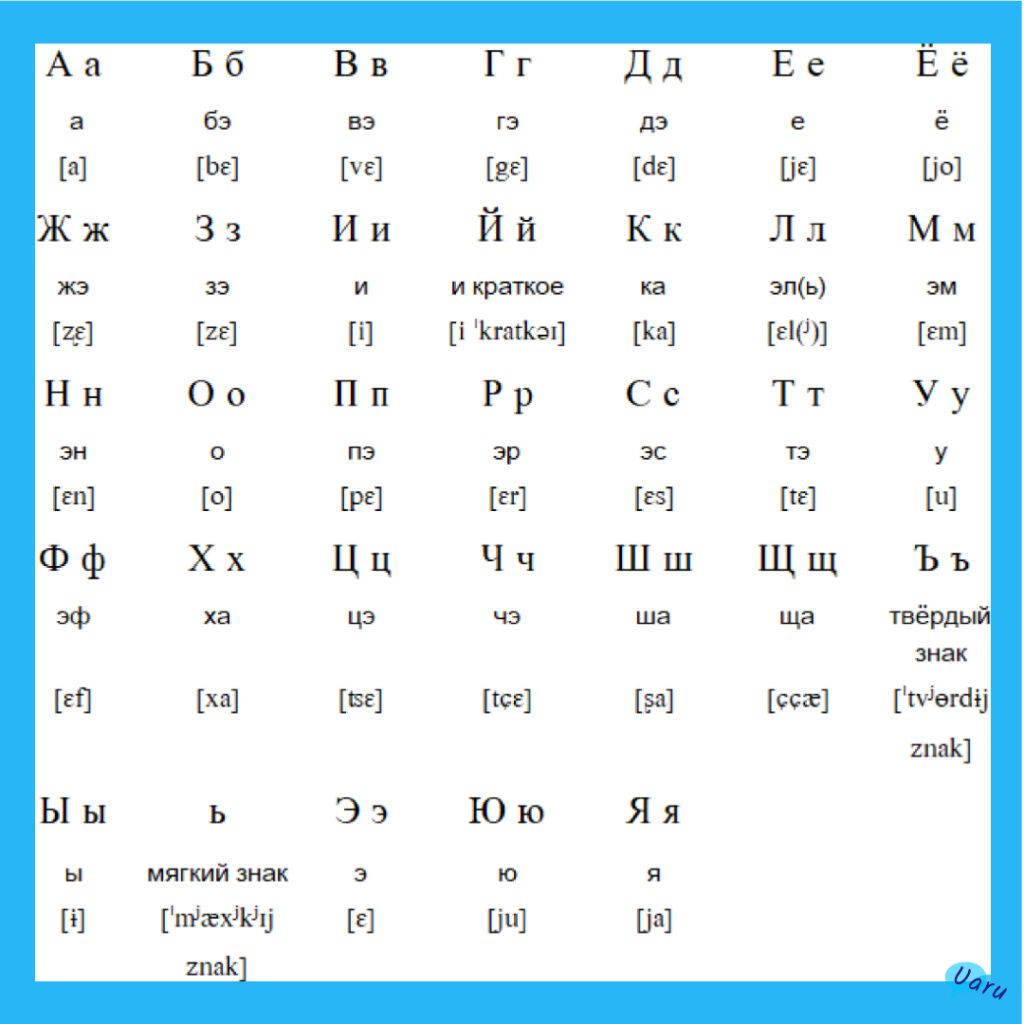
The Russian alphabet consists of thirty-three letters representing thirty-one sounds and two signs that have no phonetic value of their own.
There are 21 consonant letters in Russian: б, в, г, д, ж, з, к, л, м, н, п, р, с, т, ф, х, ц, ч, ш, щ. The consonant letter й is sometimes called a semivowel.
There are 10 vowel letters: а, э, ы, у, о, я, е, ё, ю, и.
Two letters of the Russian alphabets do not designate any sounds. They are the “soft sign” (ь) and the “hard sign” (ъ).
If you wish to read Russian, you need to learn the alphabet thoroughly. This table will help you to do so.
А а
“a” in “father” or “car”
Áнглия
Б б
“b” in “bit”
Банáн, Бéльгия
В в
“v” in “vine”
Водá, ви́но
Г г
“g” in “go”
Гóд, ги́мн
Д д
“d” in “do”
Дóм, дя́дя
Е е
“ye” in “yes”
Енóт
Ё ё
“yo” in “yonder”
Ёж
Ж ж
“s” in “measure”, “pleasure” (As there is no english symbol for this sound, it is usually represented as “zh”)
Жýк, жи́раф
З з
“z” in “zoo”
Зáмок, зимá
И и
“ee” in “see”
Игрá
Й й
“y” in “boy”
Йод
К к
“k” in “kitten”
Кот, кинó
Л л
“l” in “lamp”
Лáмпа, лимóн
М м
“m” in “man”
Мáма, мéсто
Н н
“n” in “not”
Нóс, ня́ня
O o
“o” in “folk”
Он
П п
“p” in “pet”
Пáпа, пи́во
Р р
“r” in roll
Рот, Рим
С с
“c” in “city”
Спорт, семья
Т т
“t” in “tap”
Такт, телефóн
У у
“oo” in “root”
У́хо
Ф ф
“f” in “fine”
Флот, финáнсы
Х х
“h” in “hello”
Хор, хи́мия
Ц ц
“ts” in “its”
Ценá
Ч ч
“ch” in “chips”
Час, чек
Ш ш
“sh” in “ship”
Шар
Щ щ
“sh” in “sheer” (with your tongue on the roof of your mouth)
Щука, щи
Ъ ъ
‘Hard Sign’ makes preceding consonant hard
Объясня́ть, объём
Ы ы
“i” in “ill” (Said with your tongue slightly back in your mouth. There is no english symbol for this sound)
Ты, мы
Ь ь
‘Soft Sign’ makes the previous letter ‘soft’
Соль, конь
Э э
“e” in “met”
Эстóния
Ю ю
“u” in “use”
Юг
Я я
“ya” in “yard”
Я́хта
Basic Russian reading rules.
Most consonants can be either soft or hard in Russian (in the table above you two examples for each of these letters to demonstrate both hard and soft variants).
The consonant is hard before the hard sign (ъ), other consonants, or the vowels – а, о, у, э, ы.
The consonant is soft before the soft sign (ь) or the vowels – я, ё, ю, е, и.
However, ш, ж, and ц are always hard, while ч and щ are always soft.
Soft and hard signs we use not only to makes the previous letter softer on harder but also to separate a consonant from a vowel in a word (for example, «семя» [s′ém′ʌ] и «семья» [s′im′jʌ́] are two different words).
Reduction of vowels: Russian words are typically long, and most don’t feature stress (accent) marks. The problem is that there are no general rules for the placement of the stress marks, and the word may change grammatical meaning if the stress mark is changed. Some vowels change sounds depending on if they’re in stressed or unstressed positions. The letters е, о, э and я change sounds when stressed or unstressed. For example, unstressed o is pronounced like unstressed a. But when it is stressed, is sounds like English aw in law.
Subscribe to our newsletter!
